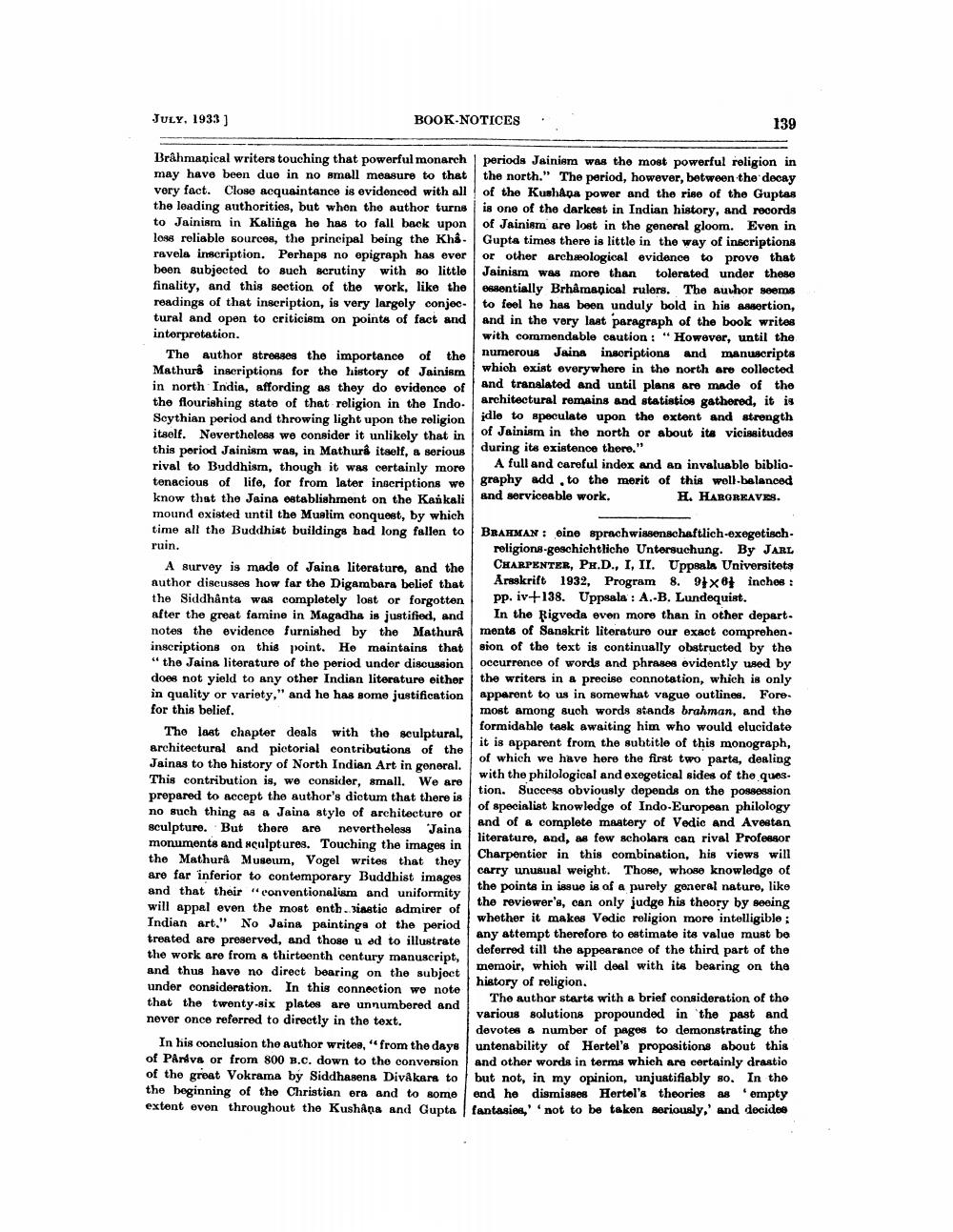________________
JULY, 1933 ]
BOOK-NOTICES.
139
Brahmapical writers touching that powerful monarch | periods Jainism was the most powerful religion in may have been due in no small measure to that the north." The period, however, between the decay very fact. Close acquaintance is evidenced with all of the KushApa power and the rise of the Guptas the leading authorities, but whon the author turns is one of the darkest in Indian history, and records to Jainism in Kalinga he has to fall back upon of Jainism are lost in the general gloom. Even in lose reliable sources, the principal being the Khê. Gupta times there is little in the way of inscriptions ravela inscription. Perhaps no epigraph has ever or other archeological evidence to prove that been subjected to such scrutiny with so little Jainism was more than tolerated under these finality, and this section of the work, like the essentially Brhåmanical rulers. The auvhor seems readings of that inscription, is very largely conjec. to feel he has been unduly bold in his assertion, tural and open to criticism on points of fact and and in the very last paragraph of the book writes interpretation.
with commendable caution : "However, until the The Author atresses the importance of the numerous Jains inscriptions and manuscripts Mathurs inscriptions for the history of Jainism which exist overywhere in the north are collected in north India, affording as they do evidence of
And translated and until plans are made of the the flourishing state of that religion in the Indo
architectural remains and statistics gathered, it is Soythian period and throwing light upon the religion
idle to speculate upon the extent and strength itself. Nevertheless we consider it unlikely that in
of Jainism in the north or about its vicissitudes this period Jainism was, in Mathurâ itself, a serious
during its existence there." rival to Buddhism. though it was certainly more A full and careful index and an invaluable bibliotenacious of life, for from later inscriptions wegraphy add to the merit of this woll-balanced know that the Jaina establishment on the Kankali and serviceable work.
H. HARGREAVES. mound existed until the Muslim conquest, by which time all the Buddhist buildings had long fallen to BRAHMAN : eine sprachwissenschaftlich-exegetischruin.
religions-geschichtliche Untersuchung. By JARL A survey is made of Jaina literature, and the
CHARPENTER, PH.D., I, II. Uppsala Universitets author discusses how far the Digambara belief that
Araskrift 1932, Program 8. 97 X 8 inches : the Siddhanta was completely lost or forgotten Pp. iv+138. Uppsala : A.-B, Lundequist. after the great famine in Magadha is justified, and In the Rigveda even more than in other depart. notes the evidence furnished by the Mathura ments of Sanskrit literature our exact comprehen. inscriptions on this point. Ho maintains that sion of the text is continually obstructed by the "the Jaina literature of the period under discussion occurrence of words and phrases evidently used by does not yield to any other Indian literature either the writers in a precise connotation, which is only in quality or variety," and he has some justification apparent to us in somewhat vague outlines. Fore. for this belief.
most among such words stands brahman, and the The last chapter deals with the sculptural,
formidable task awaiting him who would elucidato architectural and pictorial contributions of the
it is apparent from the subtitle of this monograph, Jainas to the history of North Indian Art in general.
of which we have here the first two parte, dealing This contribution is, we consider, small. We are
with the philological and exegetical sides of the ques. prepared to accept the author's dictum that there is
tion. Success obviously depends on the possession no such thing as a Jaina stylo of architecture or
of specialist knowledge of Indo-European philology
and of & complete mastery of Vedic and Avestan sculpture. But there are nevertheless Jaina
literature, and, as few scholars can rival Professor monuments and sculptures. Touching the images in the Mathura Museum, Vogel writes that they
Charpentier in this combination, his views will are far inferior to contemporary Buddhist images
carry unusual weight. Those, whose knowledge of and that their
the points in issue is of a purely general nature, like conventionalism and uniformity
the reviewer's, can only judge his theory by seeing will appal even the most enth.sinatia admirer of Indian art." No Jaina paintings of the period
whether it makes Vedic religion more intelligible : treated are preserved, and those u od to illustrate
any attempt therefore to estimate its value must be the work are from a thirteenth century manuscript,
deferred till the appearance of the third part of the and thus have no direct bearing on the subject
memoir, which will deal with its bearing on the under consideration. In this connection we note
history of religion.
The author starts with a brief consideration of the that the twenty-six plates are unnumbered and
various solutions propounded in the past and never once referred to directly in the text.
dovotes & number of pages to demonstrating the In his conclusion the author writes, from the daye untenability of Hertel's propositions about this of PAndva or from 800 B.C. down to the conversion and other words in terms which are certainly draatio of the great Vokrama by Siddhagena Divakars to but not, in my opinion, unjustifiably so. In tho the beginning of the Christian era and to some end he dismisses Hertel's theories as empty extent even throughout the Kushina and Gupta fantasies, not to be taken seriously, and decide




